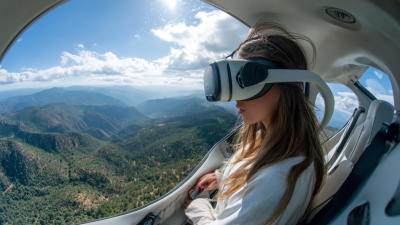How to Experience the Future of Entertainment with VR Theme Parks
Table of Contents
- Exploring the Rise of VR Theme Parks in the Entertainment Industry
- Key Technologies Driving Innovation in VR Theme Parks
- Market Growth: Projected Revenue of VR Entertainment to Reach $250 Billion by 2025
- Creating Immersive Experiences: The Role of 360-Degree Content in VR Parks
- Consumer Trends: Understanding Visitor Demographics and Preferences in VR Experiences
- Safety and Accessibility: Addressing Challenges in VR Theme Park Design and Operation
- FAQS
- Conclusion
- Related Posts
As the entertainment industry continues to evolve, VR Theme Parks are at the forefront of this transformation, merging advanced technology with immersive experiences. According to a report by MarketsandMarkets, the virtual reality market is projected to reach $57.55 billion by 2027, with a significant portion driven by the rise of VR theme parks providing unique attractions that captivate audiences.

Guangzhou Longcheng Electronic Co., Ltd., VART VR, is one of the earliest VR simulator manufacturers in China, offering cutting-edge VR solutions tailored for this burgeoning sector. With an extensive 8000 square meter facility and a dedicated team of over 60 professionals, VART VR is poised to provide comprehensive one-stop VR or cinema projects. As the demand for innovative entertainment experiences grows, leveraging VR technology in theme parks presents a groundbreaking opportunity for both businesses and consumers to explore the future of entertainment.
Exploring the Rise of VR Theme Parks in the Entertainment Industry
The rise of VR theme parks marks a transformative moment in the entertainment industry, merging digital experiences with physical interactions. As technology continues to advance, these immersive environments utilize cutting-edge virtual reality to create engaging attractions that captivate audiences of all ages. Unlike traditional amusement parks that primarily rely on mechanical rides, VR theme parks offer a unique blend of storytelling and interactivity, allowing visitors to step into a variety of fantastical worlds.

As consumers increasingly seek novel experiences, VR theme parks are positioned to meet this demand with tailor-made adventures. From thrilling roller coasters enhanced by virtual scenery to fully immersive escape rooms, these parks provide an unprecedented level of escapism and engagement. Additionally, the integration of social elements, such as multiplayer experiences, fosters a shared sense of exploration among visitors, enhancing the overall enjoyment. The future of entertainment lies within these innovative spaces, as they continuously evolve to offer even more groundbreaking experiences.
Key Technologies Driving Innovation in VR Theme Parks
Virtual Reality (VR) theme parks are revolutionizing the entertainment landscape, harnessing cutting-edge technologies to create immersive experiences that transport visitors to new worlds. A pivotal aspect driving this innovation includes advanced VR headsets, which have seen significant advancements in display resolution and field of view. According to a report by Market Research Future, the global VR market is projected to reach approximately $44.7 billion by 2024, indicating a burgeoning demand for high-quality immersive experiences.
In addition to hardware improvements, the integration of haptic feedback technology is enhancing user engagement. This technology allows guests to physically feel their surroundings, increasing the realism of virtual environments. For instance, a study conducted by PwC predicts that up to 30% of all entertainment experiences could be VR-based by 2030. Concurrently, artificial intelligence (AI) is playing a crucial role by personalizing experiences, adapting scenarios based on individual user preferences and behaviors, thus creating an unprecedented level of interactivity. As these key technologies evolve, VR theme parks are poised to redefine what entertainment means in the digital age.
Market Growth: Projected Revenue of VR Entertainment to Reach $250 Billion by 2025
The VR entertainment market is poised for remarkable growth, with projections indicating a revenue surge to $250 billion by 2025. This trend highlights the increasing demand for innovative experiences that blend technology with entertainment. As more consumers seek immersive environments, the potential for VR theme parks to transform the landscape of leisure activities becomes undeniable. The ability to offer thrilling, interactive experiences through virtual reality is revolutionizing the entertainment sector.
In this rapidly evolving market, companies like Guangzhou Longcheng Electronic Co., Ltd., VART VR stand at the forefront. As one of China's earliest VR simulator manufacturers, VART VR has been instrumental in shaping the future of entertainment. With a spacious facility covering 8,000 square meters and a dedicated team of over 60 professionals, VART VR specializes in providing comprehensive VR and cinema projects. This one-stop solution not only emphasizes technological innovation but also enhances the overall consumer experience, positioning the company as a key player in the burgeoning VR entertainment industry.
Creating Immersive Experiences: The Role of 360-Degree Content in VR Parks
Virtual reality (VR) theme parks represent a transformative shift in the entertainment industry, offering unparalleled immersive experiences that captivate audiences. Central to this evolution is the use of 360-degree content, which allows visitors to fully engage with their surroundings. According to a report by MarketsandMarkets, the global virtual reality market is projected to grow from $15 billion in 2020 to over $57 billion by 2027. This rapid expansion underscores the increasing demand for innovative entertainment solutions, particularly in the realm of immersive experiences that VR theme parks provide.

360-degree content plays a vital role in creating these experiences. By utilizing advanced technologies to simulate realistic environments, visitors can explore and interact with various elements from multiple angles. A survey by Statista indicates that over 75% of respondents believe that VR enhances their overall enjoyment of theme park attractions. This sentiment highlights the effectiveness of 360-degree content in not only entertaining but also immersing guests in narratives that were previously unimaginable in traditional amusement settings. With the integration of VR and 360-degree media, theme parks are poised to redefine the way audiences experience entertainment in the future.
Consumer Trends: Understanding Visitor Demographics and Preferences in VR Experiences
Understanding visitor demographics and preferences in VR experiences is vital for the success of VR theme parks. According to a report by PwC, the VR entertainment market is projected to grow by 30% annually, reaching $11.5 billion by 2025. This growth is fueled by younger consumers, particularly millennials and Gen Z, who are increasingly drawn to immersive and interactive experiences. Research indicates that 70% of this demographic values unique experiences over traditional entertainment, making VR parks a significant attraction.
To cater to these preferences effectively, VR theme parks should consider several key factors. First, the integration of social elements, such as multiplayer experiences, can enhance visitor engagement. A survey by Statista shows that 65% of potential VR users prefer experiences that they can share with friends. Additionally, offering a variety of content, from thrilling rides to educational simulations, can appeal to a broader audience.
**Tips:** Focus on creating diverse experiences that cater to different age groups and interests. Utilize social media to promote unique features and experiences within the park, encouraging guests to share their adventures online. Lastly, gather visitor feedback regularly to adapt attractions based on preferences and trends, ensuring continuous improvement and satisfaction.
How to Experience the Future of Entertainment with VR Theme Parks - Consumer Trends: Understanding Visitor Demographics and Preferences in VR Experiences
| Demographic Group | Age Range | Percentage of Visitors | Preferred VR Experience Types | Average Visit Duration (Hours) |
|---|---|---|---|---|
| Children (6-12) | 6-12 | 25% | Adventure Rides, Educational Experiences | 2 |
| Teenagers (13-19) | 13-19 | 30% | Action Games, Escape Rooms | 3 |
| Young Adults (20-35) | 20-35 | 25% | Immersive Storytelling, Multiplayer Games | 4 |
| Adults (36-55) | 36-55 | 15% | Relaxation Experiences, Virtual Tours | 2.5 |
| Seniors (56+) | 56+ | 5% | Memory Experiences, Cultural Simulations | 1.5 |
Safety and Accessibility: Addressing Challenges in VR Theme Park Design and Operation
As virtual reality (VR) theme parks emerge as the next frontier in entertainment, addressing safety and accessibility becomes paramount to ensure an enjoyable experience for all visitors. VR technology often requires participants to wear headsets and interact with immersive environments, which can pose risks such as motion sickness, disorientation, or even physical injuries. Designers must incorporate measures like clearly marked pathways, safety harnesses, and space for movement to create an accessible environment. These elements are essential for minimizing accidents and ensuring that users can safely engage with the VR attractions without fear of harm.
Moreover, accessibility extends beyond physical safety to include inclusivity for individuals with varying abilities. It is crucial that VR theme parks provide adaptable equipment and experiences, such as audio descriptions for the visually impaired or haptic feedback for those with hearing loss. By employing user-centered design principles, operators can offer a variety of experiences tailored to different needs, making VR entertainment accessible to a broader audience. The successful integration of these safety protocols and accessibility features will ultimately enhance user satisfaction, promote repeat visits, and solidify VR theme parks as a leading entertainment option for diverse populations.
Safety and Accessibility in VR Theme Parks
FAQS
: VR theme parks are immersive environments that blend digital experiences and physical interactions, utilizing virtual reality to create engaging attractions for visitors.
Unlike traditional amusement parks that rely on mechanical rides, VR theme parks offer a unique combination of storytelling and interactivity, allowing visitors to engage with a variety of virtual worlds.
VR theme parks provide tailor-made adventures, including enhanced roller coasters with virtual scenery and fully immersive escape rooms, focusing on escapism and engagement.
The VR entertainment market is expected to reach a revenue of $250 billion by 2025, reflecting a growing demand for innovative, immersive experiences.
Social elements, such as multiplayer experiences, allow visitors to share their exploration and enhance the overall enjoyment of the attractions.
Companies like Guangzhou Longcheng Electronic Co., Ltd. and VART VR are significant contributors, with VART VR being one of China's earliest VR simulator manufacturers.
VART VR emphasizes technological innovation and enhances the consumer experience by providing comprehensive VR and cinema projects in a large facility with a dedicated team.
Consumers are increasingly seeking novel experiences, and VR theme parks meet this demand by offering unique, engaging adventures that immerse them in fantastical worlds.
Technological advancements are crucial in creating the engaging attractions found in VR theme parks, continuously evolving to provide groundbreaking experiences.
The future of entertainment will likely focus on further innovation in VR theme parks, delivering even more captivating and interactive experiences for visitors.
Conclusion
The article discusses the burgeoning phenomenon of VR theme parks and their transformative impact on the entertainment industry. With advancements in key technologies, these parks are reshaping visitor experiences by offering immersive environments powered by 360-degree content. As projected revenue from VR entertainment is expected to soar to $250 billion by 2025, understanding consumer trends is crucial. This includes analyzing visitor demographics and preferences to better cater to their desires. Furthermore, the article emphasizes the importance of addressing safety and accessibility challenges to enhance the overall design and operation of VR theme parks.
Guangzhou Longcheng Electronic Co., Ltd. VART VR, as a prominent player in the VR simulator manufacturing sector in China, is well-positioned to contribute to this exciting evolution. With a dedicated team and extensive experience, VART VR offers comprehensive solutions for VR theme parks, ensuring that they remain at the forefront of this dynamic market.
Related Posts
-

Understanding Challenges Faced by Users of Vr Equipment in Various Industries
-

How to Choose the Best VR Flight Games for an Immersive Experience
-

How to Elevate Your Business with Vr Flight Solutions
-

5 Tips for Mastering Your Experience with Vr Flying Simulator
-

Addressing Common Issues in VR Airplane Simulators: Solutions for Improved Experiences
-

The Definitive Guide to Understanding Vr Machine Price and Its Market Trends

